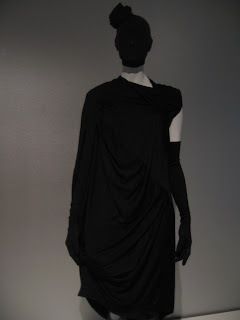Yohji Yamamota, 1983 Spring/Summer white cotton plain-weave cut work jacket and dress.
I really like the way that the fabric has been cut to form this intricate detail, it is most likely cut using a laser cutting cad system.
Jun Takahashi/undercover, Spring/Summer 06This garment attracted my attention due to the volume of the piece and that it is made up of small circles creating an interesting texture.
Rei Kawakubo,
Spring Summer 2009
Junya Watanabe, Autumn/Winter 2009-10It was the volume of this garment which also attracted my attention. The chains wrapping around the body creates the effect that the bottom of the garment is trying to escape from this restriction.
Naoya Hatakeyama, 2009
This coat is made out of a fine plastic and is made out of pockets containing paper with Japanese writing on. This is a very literal portrayal of language as a form of communication but interesting and innovative none the less.
Junya Watanabe, Autumn/Winter 2000
Junya Watanabe had various garments from her collections at the exhibition but this one, to me was the most striking. I love the way that the material is folded and the intricate shape that explodes from the wearer’s neck.
Tas Kurishana, 2005-6
The knitting and crochet on these garments is what struck me. Knitting is not normally associated witch corsetry and underwear but it looks incredibly delicate and pretty.
This interested me because of the face being covered up. This suggested to me that this garment really is a piece of art and the wearer is not important.
Issey Miyake
This garment to me looks a lot like origami and this can be seen in the pattern piece photographed underneath the garment. This is an interesting and innovative way of pattern cutting and adding detail to the garment.
Tamae Hitokawa















No comments:
Post a Comment